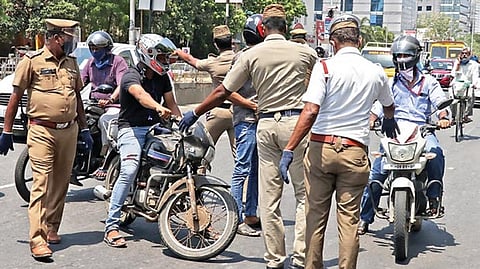

CHENNAI: A study conducted by Citizen Consumer and Civic Action Group (CAG) has found overspeeding of vehicles, including two-wheelers and cars, along 15 major arterial stretches in the city as against the speed limits.
According to the report titled “Slowdown - An assessment of speeding concerns and their management in Chennai”, speeding is driving too fast or the behaviour of exceeding posted speed limits has far-ranging consequences and is one of the significant factors contributing to road crashes.
As per the State Crime Records Bureau (SCRB) report of 2020, 98.57 per cent of the State accidents occurred due to driver’s fault, including speeding and aggressive driving.
The authors of the report Varsha Vasuhe V, researcher, CAG and Sumana Narayanan, senior researcher, CAG conducted spot speed surveys to examine variations in speeding across selected vehicle categories in 15 major arterial stretches in the city. The stretches include GNT Road, Anna Nagar, EVR Salai, Anna Salai, Peters Road, Harrington Road, Adyar, GST Road and ECR were studied.
Sumana of CAG said that the findings revealed a high driver non-compliance to the posted speed limits and the trend is similar across the different vehicle categories with contextual variations depending upon the road class and quality of existing infrastructure. The Anna Salai arterial stretch witnesses consistent speeding by two-wheelers and cars at Nandanam and Teynampet with 85 per cent of the two-wheelers travelling at or below a speed of 53 km per hour and 66 km per hour as against the speed limit of 40 kmph. “The cars consistently exhibited speeding behaviour (compared to motorbikes) in the Teynampet area with 85 per cent of them travelling at/ below a speed of 75 kmph despite witnessing heavy traffic, ” she said.
The senior researcher said that the arterial stretch along ECR in Akkarai witnessed relatively less speeding due to the variable message sign board, vehicle actuated speed sign and the auto-generated challans have likely significantly impacted reducing speeding. All 15 locations witnessed consistent speeding by autos and share autos.
Sumana recommended the need to couple speed limits with supporting laws and speed policies, active enforcement strategies, public education, and reviewing the legislated process of formulating speed limits. The study also concludes that legislators should consult traffic engineers, policymakers, public health officials and all road users to come up with appropriate speed limits that place safety at the forefront and exhibits a judicious trade-off in terms of travel time and feasibility of enforcement. She said that speed limits signboards are neither visible nor present on most of the arterial stretches.
Visit news.dtnext.in to explore our interactive epaper!
Download the DT Next app for more exciting features!
Click here for iOS
Click here for Android